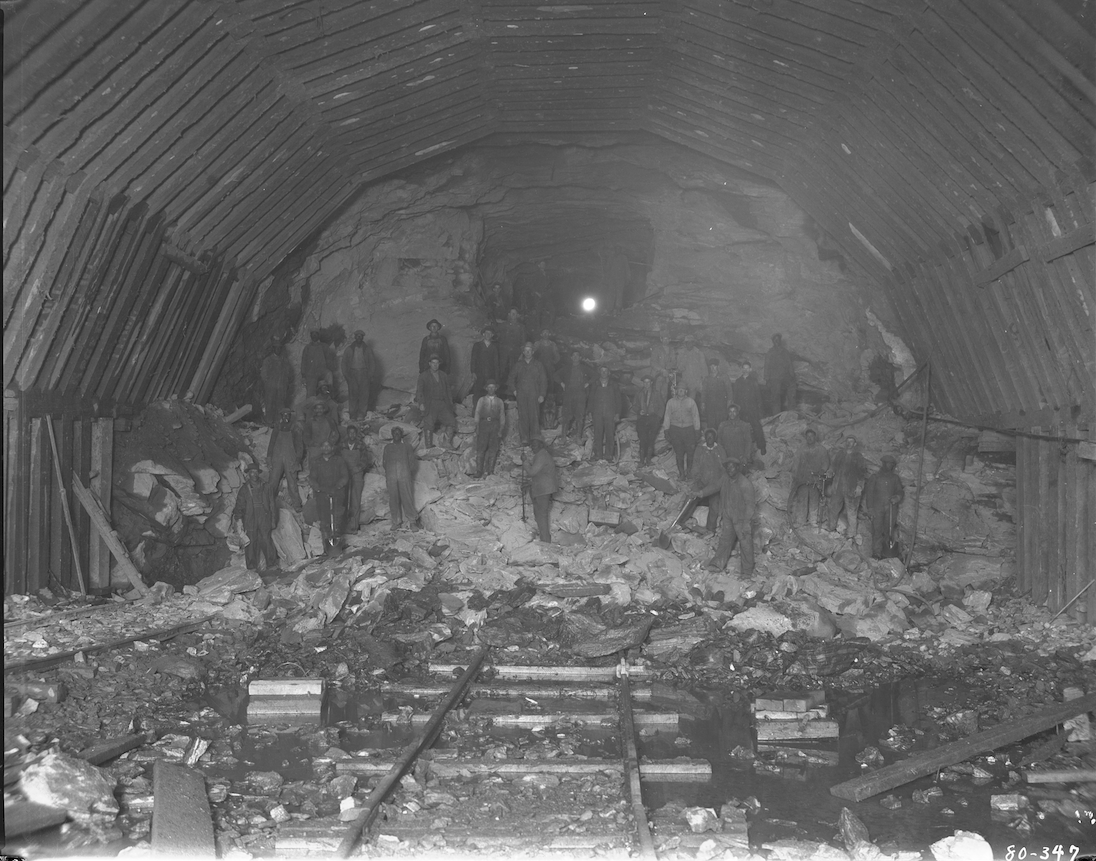In May 1927, work officially began on Beaucatcher Tunnel. Controversy and catastrophe would haunt the two-year project.
“A few years ago Battery Park hill got in the way of progress and it was leveled down,” declared the Dec. 4, 1927, edition of The Sunday Citizen. “Now Beaucatcher mountain is in the way and Asheville is running a street under it.”
The article went on to describe the project’s perilous and deafening work. “When the pneumatic drills start up the place is like a cavern of thunders,” the paper wrote. “Like ants working at a barrel of sugar these men are gradually eating through the steel-hard granite, while the tiny mountain of muck grows at the mouth of the tunnel.”
Nearly a year into the project, disaster struck. On April 25, 1928, The Asheville Citizen reported that part of the tunnel had caved in, after weeks of ongoing concern expressed by engineers and workers. No deaths or injuries were suffered. But a steam shovel, two flat cars, roughly 50 feet of track and tools were buried beneath the earth. The cave-in would result in a 30-day delay and cost the $302,536 project an additional $6,500.
By May, politicians pointed to the tunnel with cynicism and contempt, using it as a talking point against reckless spending. In the May 31 edition of The Asheville Citizen, Hubert C. Jarvis, candidate for the lower house of the state Assembly declared, “Four or five fine schools could have been built in Buncombe county for the money that is being expended on the Beaucatcher tunnel[.]”
In the same article, fellow candidate Joshua A. Curtis promised, “If I can get to Raleigh before the workers at the Beaucatcher tunnel can pull the slide off their tools, I’ll introduce a bill to stop up both ends of the thing and let it remain like God made it.”
Opposition continued into the fall. On Nov. 1, a group of self-described “life long Democrats,” took out a half-page advertisement in The Asheville Citizen that listed a series of questions to Democratic candidates of Buncombe County. The top inquiry read:
“Are you proud of that Beaucatcher Tunnel? Can you state how much it will cost the taxpayers of Buncombe County and how much in professional fees will be paid to the Howerton Engineering Company to this tunnel?”
Supporters of the project, however, were undeterred. On Nov. 4, Asheville engineer Robert S. Brown took out his own ad in The Asheville Citizen. It began with a the same question: “are YOU proud of the BEAUCATCHER TUNNEL?”
Brown continued:
“Well—you should be. And here is why! More than 5696 cars PER DAY will EACH save ONE MILE when BEAUCATCHER TUNNEL is completed. Figure 5696 car-miles per day at only 8c per car-mile and you get a net SAVING of $455.68 per day, $166,323.20 per years, $498,969.60 in three years.
THINK OF THAT!
In TWO and ONE-HALF YEARS more than the ENTIRE cost of this project will be SAVED to Buncombe County taxpayers.”
Nearly a year would pass before the project’s completion. On Sept. 1, 1929, the tunnel finally opened. The following day’s paper reported that 7,000 cars drove through it that day.
Amid the excitement, few could have imaged what lurked around the corner. On Oct. 24, 1929 — less than two months after the tunnel’s completion — The Asheville Citizen reported, “Near panic hits market in last hour of trading.” The Great Depression had begun.
Editor’s note: Peculiarities of spelling and punctuation preserved from the original documents.






What a nifty article – thanks for bringing this bit of history to life in such an interesting way.
Thanks for reading and leaving a comment, Carl.
Nifty?
shocked there were that many cars in the area to utilize it so fast …
I was under the impression that T.M. Howerton was the engineer company for the tunnel?